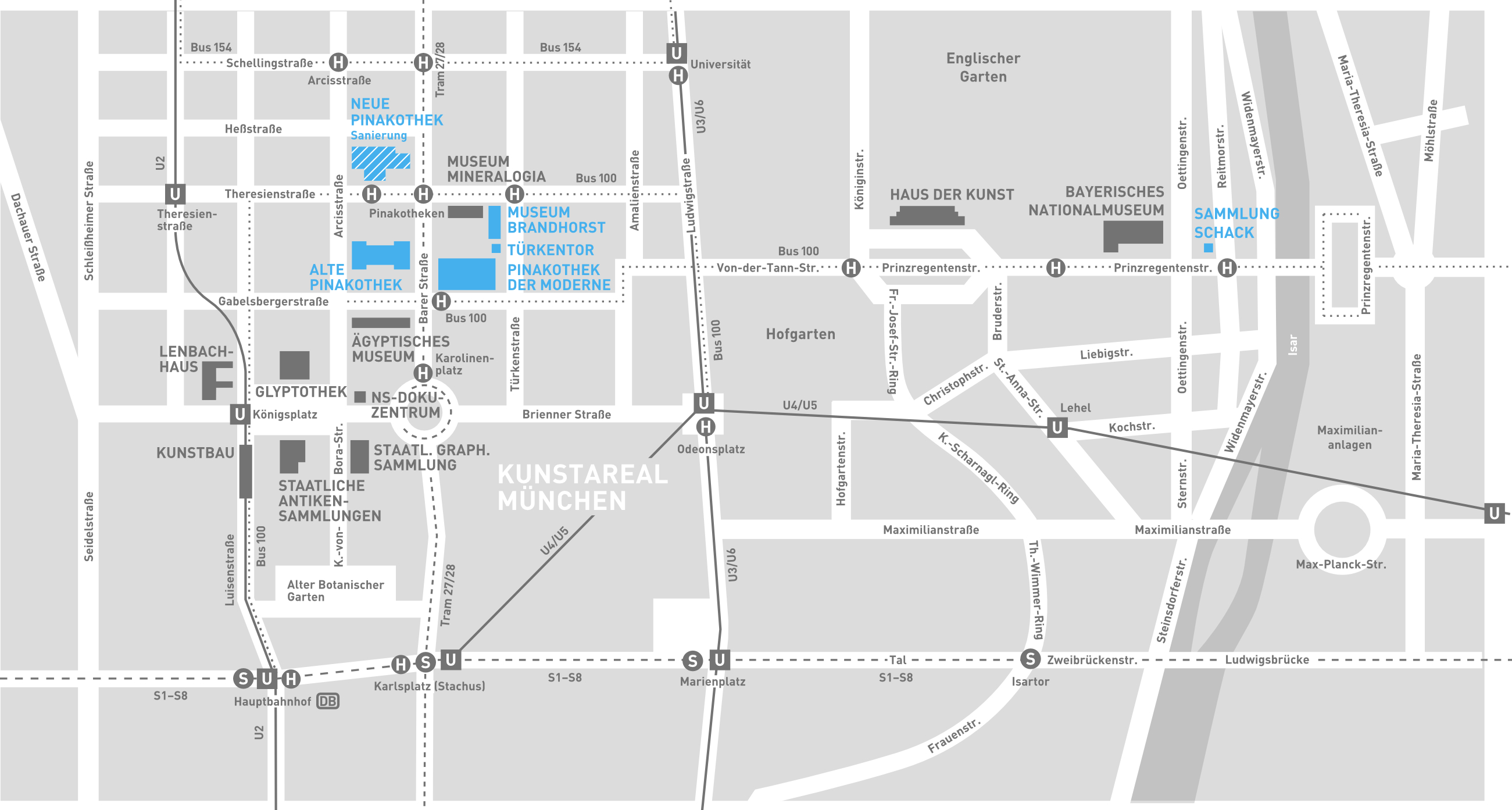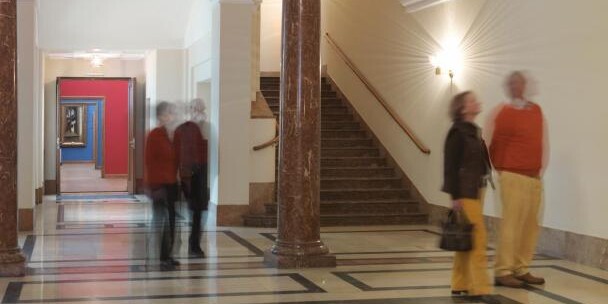With the Online Collection, the Bayerische Staatsgemäldesammlungen (Bavarian State Painting Collections) have been presenting their entire art collection since 2017: 25,000 works of art in Bavaria, Germany and Europe on one platform! It is thus possible for everyone interested to gain an overview not only of the works of art on display in the Munich museums and the branch galleries in Bavaria, but also of the deposited artworks (17,000 works) and more than 4,000 permanent loans from the Munich collection, which are located at more than 400 locations in institutions, some of which are open to the public.

Sammlung Schack
Sammlung Schack
Admission
Permanent collection
Admission is free for children and young people under the age of 18.
Students and visitors over 65 years of age receive reduced admission.
4
€
3 € reduced
Sunday
Pinakotheken, Museum Brandhorst and Sammlung Schack
1
€
per museum
Day pass
Pinakotheken, Museum Brandhorst, Sammlung Schack | Only available at the museum ticket office
12
€
Annual ticket
Annual tickets are available at the ticket offices in our museums as well as in the online ticket shop of the state museums and collections.
Pinakotheken, Museum Brandhorst and Sammlung Schack
90
€
60 € reduced
Impressions of the Sammlung Schack
Please note that when you play the video, cookies are stored on your device and a connection to the USA is established. The USA is not a safe third country in the sense of EU data protection law. With your consent, you also agree to the processing of your data in the USA. You can find further information in our privacy policy.
Current exhibitions
Masterpieces of the Sammlung Schack

Adolf Friedrich Graf von Schack
A poet and literary historian
Count Adolf Friedrich von Schack was born in Schwerin in the German principality of Mecklenburg in 1815. He began his career as a lawyer and diplomat in the local civil service, but relinquished his post in 1851 in order to devote himself entirely to literary interests. In 1856 Maximilian II of Bavaria invited him to Munich, where he joined the circle of scientists, scholars and writers the king had gathered there to make the city a centre of German intellectual life comparable to eighteenth-century Weimar. Schack numbered among his friends the celebrated poets Emanuel Geibel and Paul Heyse. After the death of Maximilian, in 1864, Schack’s ties with Munich became looser. He travelled widely during the last thirty years of his life, visiting Italy, Spain, Greece and the Middle East. He died in Rome in 1894.
Schack regarded his literary and critical work as his most important achievement. He wrote on the theatre in seventeenth-century Spain and on the Arabian culture of medieval Spain and southern Italy. He had a profound knowledge of Oriental literature and produced a German translation of Firdousī’s Shahnama (The Book of Kings), a major work of Persian poetry. In later years he focused increasingly on his own poetry, taking the subjects of his epic poems and plays from periods of transition and upheaval such as Late Antiquity, the Renaissance and the Reformation. His models were Byron and the German author August von Platen. In 1888 Schack published his autobiography, Ein halbes Jahrhundert (Half a Century), which describes his travels and his encounters with important figures of his time. Today, his poetry is almost completely forgotten, and he is remembered principally for his collection of paintings, amassed mostly in the 1860s and ’70s.

Schack’s chief aim as an art collector was to promote the work of underrated and young, unknown artists. Among those he supported by means of regular purchases and commissions were Moritz von Schwind, whose idealistic approach had been relegated to the sidelines as a result of the triumphant progress of Realism, and the young painters Arnold Böcklin, Anselm Feuerbach and Hans von Marées, whom the contemporary art market disregarded. Although Schack was familiar with the French art of his day and greatly admired Eugène Delacroix, he deliberately acquired work only by German-speaking artists.
Schack’s paintings, the genres to which they belong and their subjects, reflect his own interests and predilections. His notion of art was fundamentally idealistic, and that automatically precluded all forms of Realism. ‘Poetry is the mother of all the arts,’ he wrote, ‘and both painters and musicians may be termed genuine artists only when they are imbued with the poetic spirit in the way that poets are.’ Most works in the collection are therefore history paintings or landscapes. With one or two exceptions, notably works by Spitzweg, the genre painting so popular in Schack’s day is absent.
The landscapes depict motifs from Mediterranean countries: Italy, Greece and especially Spain, which Schack visited on many occasions. Böcklin’s and Feuerbach’s paintings show not only the gods and myths of ancient Greece and Rome, but also subjects taken from the work of later poets, from Dante and Petrarch to Goethe. Schwind’s pictures evoke the sagas and legends of medieval Germany, which had been rediscovered in the late eighteenth century and invoked as an alternative to classical antiquity.
Along with work by his contemporaries, Schack collected copies of major sixteenth- and seventeenth-century paintings, notably of such Venetian artists as Giorgione, Titian, Tintoretto and Veronese. Among the copyists was the young Franz von Lenbach, later to become Germany’s leading portrait painter.
Classical antiquity, the Middle Ages and the Renaissance; Greece, Italy and the Spain of Romantic imagination: these eras, these places provided a focus for escapist longings, offering a refuge from the upheavals of the dawning modern age. The collection put together by the cosmopolitan Schack reflects this with compelling force. The paintings conjure up far-off times and realms as an expression of contemporary desires and hopes. In 1881 Schack published his thoughts on the works in his collection in a visitors’ guide titled Meine Gemäldesammlung (My Picture Collection).
Schack’s collection was originally housed in his mansion in Brienner Strasse. It was opened to the public in 1865 and attracted a large number of visitors. The imposing building was dominated by a neo-Renaissance façade designed by Lorenz Gedon.
In 1876 Schack bequeathed his collection to the German emperor. Thus it became the property of Wilhelm II on Schack’s death in 1894. Wilhelm left the collection in Munich, and in 1909 erected the present gallery in Prinzregentenstrasse, together with a building next door for the Prussian embassy. The leading German sculptor of the day, Adolf von Hildebrand, produced the first designs for this architectural complex, which was built by Max Littmann.
The Schack-Galerie became part of the Bayerische Staatsgemäldesammlungen (Bavarian State Painting Collections) in 1939. With the exception of three paintings burned in the fire that destroyed the Munich Glaspalast in 1931 and four further losses, the collection has remained unchanged since Schack’s death.
Information for your visit

Our map (PDF) gives you an overview of the different ways to reach us.
Sammlung Schack
Prinzregentenstraße 9
80538 München
You can reach the Sammlung Schack by:
Tram
Line 16: Stop Nationalmuseum/Haus der Kunst
Line 37: Stop Friedensengel/Villa Stuck
Underground
U4 | U5: Stop Lehel
Bus
Line 100 (museum line): Stop Reitmorstraße/Sammlung Schack
Line 54 and 68: Stop Friedensengel/Villa Stuck

The Sammlung Schack with its approximately 150 paintings exhibited over three floors, unfortunately is not accessible to people with disabilities. This concerns both the access to the building via the staircase at the main entrance and the interior access to the three exhibition levels. In order to overcome this shortcoming, the Munich State Building Authority I (Staatliches Bauamt München I) has drawn up a preliminary design, which provides for the installation of a lift system and barrier-free access to the service rooms. A realisation is currently not in sight due to a lack of financial resources.
Cloakroom
The cloakroom is on the ground floor. Jackets and bags can be handed in for a fee of 1 euro per person. person can be handed in.
Information
+49 (0)89 23805 2286 (cash desk/information desk, available during regular opening hours)
+49 (0)89 23805 284 or info@pinakothek.de (Information and Service Department, available MON-FRI)
Current information
Dear visitors,
in order to ensure security in our museums, we ask for your support:
- Please hand in all items you are carrying, such as bags (of any size) and coats, at the cloakroom or deposit them in our lockers.
- Clothing, bags, or items that may be carried for special personal reasons as decided by the supervisory staff on a case-by-case basis will be inspected for their contents and then marked as checked with a wristband.
We regret the inconvenience this may cause and ask for your understanding in the interest of protecting the artworks and buildings.
Prof. Dr. Bernhard Maaz
Director General Bavarian State Painting Collections
